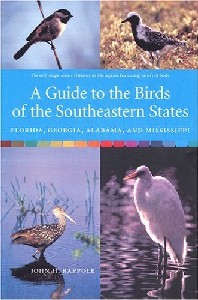Reviewed by Grant McCreary on December 23rd, 2006.
I must preface this review by stating that I don’t own this book. For that I am very thankful. I saw this title on Amazon and was interested in it, as I live in Georgia. I don’t have a problem with ordering books that I’ve never seen, but where possible I like to check them out or read some reviews first. Thankfully I came across this title at a book store. One brief examination convinced me that it wasn’t worth getting. I later went through the book more thoroughly in order to do this review.
This is not a field guide, as there is only one small photo per species. And even though it includes information about birding sites, it is not in depth enough to be a bird-finding guide. This is more of a brief introduction to the birds of this region.
The book starts with an introduction that includes some background information on the region including the ornithological history, habitat, and climate. There are also a couple of photos that are labeled with body part and feather tract names. A few of the labels are a little misleading and the photographic format is not as clear and complete as the diagrams found in the Sibley guides, for instance. The intro concludes with the obligatory “How to use this guide” section.
The bulk of the book consists of the species accounts. 376 species are covered, and it looks like the list is fairly complete. For instance, Plain Chachalaca and Red-whiskered Bulbul are both covered (there are very small, local populations of these species in Georgia and Florida, respectively). Each account is about 3/4 of a page and includes the following:
- Photograph
- Range Map – shows only the four states covered, and is color coded for summer, migration, winter, and permanent resident
- Size – measurements in inches for length and wingspan
- Brief Description
- Habits
- Voice
- Similar Species
- Habitat
- Abundance and Distribution – within the coverage area
- Where to Find – up to four sites
- Range – the species’ entire range limit
There is only one photograph per species, which will be of the breeding-plumaged male where applicable. These are very small, about 50% larger than the range maps. Some of the photos are good, most are just ok, but some are downright awful. The Purple Finch is only barely recognizable and certainly of no help in separating male Purple and House Finches. In fact, none of these photographs would be very useful for identification purposes except for the most obvious species.
The range maps don’t fare much better. There were numerous omissions for Georgia, the state I’m most familiar with. Roseate Spoonbill and Long-billed Curlew are not shown on the range map for Georgia, nor is the state listed in their text. The ranges for Purple Finch and Brown Creeper don’t extend far enough south in Georgia. The range map for Bicknell’s Thrush has the opposite problem. It is shown as being a migrant throughout all four states. According to the species’ Birds of North America (BNA) account, Bicknell’s is unreported from the west coast of Florida and the other Gulf Coast states.
One of the appendices lists all the birding
sites that were mentioned in the Where to Find
sections. There are 189 sites total, broken down as
follows: Alabama – 27; Florida – 76; Georgia – 45;
Mississippi – 41. Each listing is just a brief
paragraph, not an in-depth review of the site. Of
course, this list can’t by any means be comprehensive.
There just isn’t enough space to cover four states.
However, I did find one glaring omission – Kennesaw
Mountain is not listed for Georgia. This is perhaps the
best inland site for migrants in the state, if not the
southeast. And it is possibly the best spot in the
country for Cerulean Warblers in migration (for more
details see Kennesaw Mountain Birding).
However, it is not listed in the Cerulean’s Where to
Find section. Additionally, a bird finding guide is
recommended for each of the four states for further
information. However, the guide listed for Georgia
is an older one and not the more recent Birding Georgia by Giff Beaton (an absolutely essential
guide to anyone birding in the state).
I’m not aware of any other guide that covers only this region in a similar fashion. However, the errors and general sloppiness of this guide makes it impossible to recommend. Beginning birders would likely be frustrated at the lack of illustrations (and the poor quality of the existing ones), and those more advanced would be much better off having a regular field guide for identification, Pete Dunne’s Essential Field Guide Companion for additional information about the birds, and a state-specific bird-finding guide.
Disclosure: I get a small commission for purchases made through links in this post.



Thanks for the info, and I will continue to search for the exact book I am looking for because obviously this is NOT it.